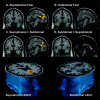Amygdala-prefrontal dissociation of subliminal and supraliminal fear
- PMID: 16281289
- PMCID: PMC6871444
- DOI: 10.1002/hbm.20208
Amygdala-prefrontal dissociation of subliminal and supraliminal fear
Abstract
Facial expressions of fear are universally recognized signals of potential threat. Humans may have evolved specialized neural systems for responding to fear in the absence of conscious stimulus detection. We used functional neuroimaging to establish whether the amygdala and the medial prefrontal regions to which it projects are engaged by subliminal fearful faces and whether responses to subliminal fear are distinguished from those to supraliminal fear. We also examined the time course of amygdala-medial prefrontal responses to supraliminal and subliminal fear. Stimuli were fearful and neutral baseline faces, presented under subliminal (16.7 ms and masked) or supraliminal (500 ms) conditions. Skin conductance responses (SCRs) were recorded simultaneously as an objective index of fear perception. SPM2 was used to undertake search region-of-interest (ROI) analyses for the amygdala and medial prefrontal (including anterior cingulate) cortex, and complementary whole-brain analyses. Time series data were extracted from ROIs to examine activity across early versus late phases of the experiment. SCRs and amygdala activity were enhanced in response to both subliminal and supraliminal fear perception. Time series analysis showed a trend toward greater right amygdala responses to subliminal fear, but left-sided responses to supraliminal fear. Cortically, subliminal fear was distinguished by right ventral anterior cingulate activity and supraliminal fear by dorsal anterior cingulate and medial prefrontal activity. Although subcortical amygdala activity was relatively persistent for subliminal fear, supraliminal fear showed more sustained cortical activity. The findings suggest that preverbal processing of fear may occur via a direct rostral-ventral amygdala pathway without the need for conscious surveillance, whereas elaboration of consciously attended signals of fear may rely on higher-order processing within a dorsal cortico-amygdala pathway.
Figures



Similar articles
-
A direct brainstem-amygdala-cortical 'alarm' system for subliminal signals of fear.Neuroimage. 2005 Jan 1;24(1):235-43. doi: 10.1016/j.neuroimage.2004.08.016. Neuroimage. 2005. PMID: 15588615
-
The dynamics of cortico-amygdala and autonomic activity over the experimental time course of fear perception.Brain Res Cogn Brain Res. 2004 Sep;21(1):114-23. doi: 10.1016/j.cogbrainres.2004.06.005. Brain Res Cogn Brain Res. 2004. PMID: 15325419 Clinical Trial.
-
A temporal dissociation of subliminal versus supraliminal fear perception: an event-related potential study.J Cogn Neurosci. 2004 Apr;16(3):479-86. doi: 10.1162/089892904322926809. J Cogn Neurosci. 2004. PMID: 15072682
-
Neural correlates of emotion processing: from emotional to social brain.Eur Neuropsychopharmacol. 2012;22 Suppl 3:S487-91. doi: 10.1016/j.euroneuro.2012.07.008. Eur Neuropsychopharmacol. 2012. PMID: 22959113 Review.
-
The role of the amygdala in human fear: automatic detection of threat.Psychoneuroendocrinology. 2005 Nov;30(10):953-8. doi: 10.1016/j.psyneuen.2005.03.019. Psychoneuroendocrinology. 2005. PMID: 15963650 Review.
Cited by
-
Neuropsychological sequelae of PTSD and TBI following war deployment among OEF/OIF veterans.Neuropsychol Rev. 2012 Mar;22(1):21-34. doi: 10.1007/s11065-012-9190-5. Epub 2012 Feb 18. Neuropsychol Rev. 2012. PMID: 22350690 Free PMC article. Review.
-
Defining biotypes for depression and anxiety based on large-scale circuit dysfunction: a theoretical review of the evidence and future directions for clinical translation.Depress Anxiety. 2017 Jan;34(1):9-24. doi: 10.1002/da.22556. Epub 2016 Sep 21. Depress Anxiety. 2017. PMID: 27653321 Free PMC article. Review.
-
How the Dorsolateral Prefrontal Cortex Controls Affective Processing in Absence of Visual Awareness - Insights From a Combined EEG-rTMS Study.Front Hum Neurosci. 2018 Oct 16;12:412. doi: 10.3389/fnhum.2018.00412. eCollection 2018. Front Hum Neurosci. 2018. PMID: 30386222 Free PMC article.
-
Brain activity induced by implicit processing of others' pain and pleasure.Hum Brain Mapp. 2017 Nov;38(11):5562-5576. doi: 10.1002/hbm.23749. Epub 2017 Aug 18. Hum Brain Mapp. 2017. PMID: 28833833 Free PMC article.
-
Aberrant Functional Connectivity of the Amygdala Complexes in PTSD during Conscious and Subconscious Processing of Trauma-Related Stimuli.PLoS One. 2016 Sep 15;11(9):e0163097. doi: 10.1371/journal.pone.0163097. eCollection 2016. PLoS One. 2016. PMID: 27631496 Free PMC article.
References
-
- Allman JM, Hakeem A, Erwin JM, Nimchinsky E, Hof P (2001): The anterior cingulate cortex. The evolution of an interface between cognition and emotion. Ann N Y Acad Sci 935: 107–117. - PubMed
-
- Adolphs R (2002): Neural systems for recognizing emotion. Curr Opin Neurobiol 12: 169–177. - PubMed
-
- Amorapanth P, LeDoux JE, Nader K (2000): Differential lateral amygdala outputs mediate reactions and actions elicited by a fear‐arousing stimulus. Nat Neurosi 3: 74–79. - PubMed
-
- Aston‐Jones G, Rajkowski J, Kubiak P, Valentino RJ, Shipley MT (1996): Role of the locus coeruleus in emotional activation. Progress Brain Res 107: 379–402. - PubMed
-
- Baddeley A, Emslie H, Nimmo‐Smith I (1993): The Spot‐the‐Word test: a robust estimate of verbal intelligence based on lexical decision. Br J Clin Psychol 32: 55–65. - PubMed
Publication types
MeSH terms
LinkOut - more resources
Full Text Sources
Other Literature Sources
Medical

